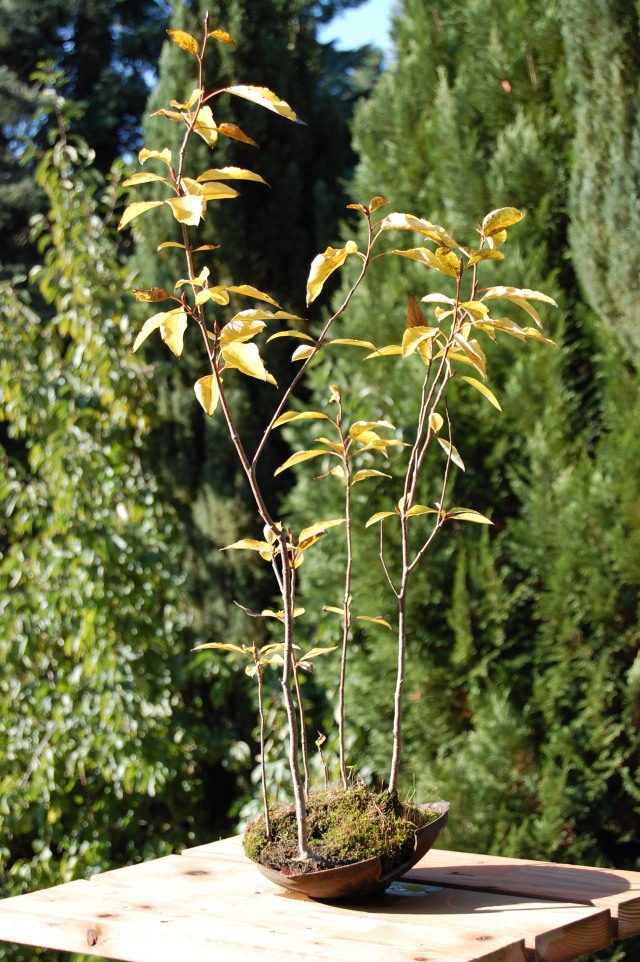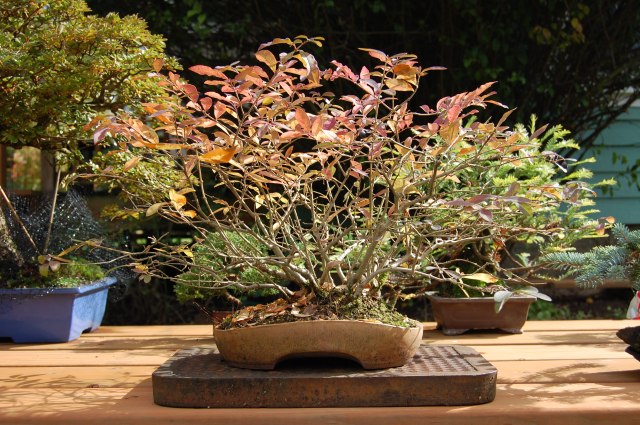Taking a break this morning from watering in the rain…I should explain that I have a few areas in my garden that are covered and any trees and plants growing there can’t get watered unless I do it for them. Even though the days are getting shorter and most visible growth has stopped, the trees and plants are still growing roots, moving resources and setting buds for the next growing season. So, it’s important not to forget those few under cover entirely. And if the neighbors didn’t know it by now, I am out of my mind 😉
As a continuation from the last post, I have begun to put trees out on the benches for this last ‘little hurrah’ of growing season and fall color enjoyment. Those of you who follow my blog know I like to work with native species and I’ll try to point these out as I show them because some of them have a special beauty that is all their own this time of year. And I couldn’t help but throw in a couple of oddballs, which I’ll try to explain in the captions. If you click on a photo, you will be able to view the image isolated from the rest of the images and there is a zoom tool that allows you to focus in closer anywhere you point your mouse…try it, you’ll like it!
I’ll start out with a lodgepole pine I collected in 2006 when I first moved to Oregon. It’s in a wood-fired pot by Ron Lang:
A ‘Chris’s Dwarf’ shohin ginkgo resting after a dip in the rain barrel. I liked the reflection in the rainwater:
Black huckleberry featured in my last blog post atop a new monkey-pole looking skyward:
The huckleberry is also a collected native from 2006; next is a cottonwood planted in a burner-well from an old electric stove found in a dump:
Another cottonwood accent plant with native grasses and an orchid–all came with the little tree:
I think the light blue color of the pot goes well with the fall foliage of this little tree. Since I’m into accent plants, here’s a sword fern planted in an old flashlight also found at a dump:
The flashlight was found while I was out collecting trees and the sword fern is a northwest native also. Big leaf maple is a tree here in the northwest that can reach gargantuan size, both the trunk and the leaves…most bonsai-ists know well enough to leave them alone. After hearing about a fellow club member talk about the one in his collection, I figured, why not? I found one growing in a basalt cliff a five minute walk from where I lived and have been able to keep it in shallow pots from when it was collected. The leaves are still a bit large, but have reduced quite a bit in size by being in a small container. I also do partial de-foliation with this throughout the growing season, removing the larger outer leaves to let sun in to the interior leaves and buds. This will induce the tree to push a second set of leaves smaller than the first set:
The pot was made by Natasha Borodovsky, a fellow Portland Bonsai Society club member exploring something new for her; I think it works well with the golden fall color and informal feeling of this tree. The next offering is kind of special since it features a tree and pot from the same maker, Mike Hagedorn, also living in Portland. The tree is a privet created from a pot full of cuttings that he gave me in exchange for caring for his privet while he was away apprenticing in Japan; I felt it only fitting that it should go into one of his pots I had on hand and here is the result:
The ‘stand’ it’s on is an iron water meter cover, also recovered from a dump while out collecting. This clump flowered prolifically this year and I spotted some fruit while out photographing yesterday. I didn’t realize they had such nice, small fruits–here’s one for you to enjoy:
Here is a wild rose (Rosa wodsii) I collected from around 7,000′ in Montana back in 1999 planted in a water meter cover as well. This species of rose is very nice in that it has very fragrant flowers, followed by fruit and is tough-as-nails. Those are the kind of plants we like in bonsai because we sometimes ask a lot of them! But they reward our efforts many times over if we care to take the time to notice:
In its orange phase now, this will turn crimson red with a little touch of frost. While I’m at it, here’s another wild rose from the same lot planted on a shovel:
Hard to believe I’ve had these for 14 years! A vine maple with some color and leaves larger than the big leaf maple:
This tree is one of the ones I kept under cover most of the summer and only brought out recently once the benches were built. I’m finding vine maples need protection from full summer sun when in containers, otherwise the leaves scorch and fall off early leaving nothing to enjoy for fall. They are an under story tree, after all, and used to living in the shade under towering Doug fir trees. Next is a lodgepole pine, Pinus latifolia, I collected in 2007 or there about and approach grafted to bring the foliage in closer to the trunk:
I got it into this temporary pot this spring, only to find the planted angle needs to be changed again!!! We’re never finished with our work on these guys! A closer shot of the trunk with some spots of shari :
My blue Atlas cedar from Jim Gremel had a good growing season since re-potting last spring, it’s in need of a cut-back and some wiring. That should be a fun fall or early winter project:
This tree comes with an interesting story I’ll elaborate on when I post it after styling. I was going to save these last few for a separate post but the sun was so good yesterday, I thought let’s roll them out…I’d like you to meet ‘Barb’ a cactus my aunt of the same name gave me in 1999 or 2000 as a single ‘arm’. She bought it in Apache Junction, Arizona, over 40 years ago on a trip to visit her mother (my Grandmother) I can remember this cactus growing in a sunny window in her house when I was a teenager…it now has 10 ‘arms’ in the 13 years I’ve had it. It has pretty pink flowers that the slugs have been dutifully eating all summer long…ah well:
The ‘pot’ it’s in is a stabilized adobe block from my days of managing an old dude ranch converted into rentals in the Tucson Mountains just outside Tucson. It’s been in there since 2004. I like to think if cactus were native to Japan, they would have used them in some way with their bonsai…maybe not. A ‘giant’ Saguaro cactus in a Mardella Brock pot is what’s next. Acquired with permission from the same dude ranch as the adobe block. I collected this in 2005 shortly before re-locating from AZ to OR and it’s still around. It’s very important to remember which way was south when you transplant Saguaros or they will sunburn and die. I always remember the ‘front’ of this guy whether it’s in the house for winter or outside for summer. It reminds me of an owl. Saguaros will grow an ‘arm’ when they reach 75 years, which is what I believe this one did for its ‘head’. It was growing in solid rock and the other cactus around it were towering giants. My estimate is that this one is over 75 years in age and towers 14″ above the rim of the pot:
It’s affectionately known as ‘Mr. Ribs’, as Saguaro cactus actually have a woody skeleton that resembles a column of long, skinny ribs and are called, well, ribs 😉 I’ll wrap up with another cactus that’s been with me since 2003 and was collected with permission to be used to make molds from for a botanical model destined for a National Park Visitor Center in Utah. A hedgehog cactus with the name ‘Claret Cup’ for the color of the flower, a bright red. These cactus grow at very high elevations (I’ve seen them at 9,000′) and are often found growing atop solid granite boulders–a very stunning sight when in full bloom. Mine has yet to flower in captivity but it does add an arm every so often. It too, is in an interesting Mardella Brock pot:
O.K., I said I’d wrap up with that, but I have to show a couple of the mushrooms that came out to play:
These belong to my Southwestern white pine and I’m sure are responsible in part to its astounding vigor. I’ll leave you with a spruce mushroom:
This little guy popped up at the base of a Sitka spruce forest. One of the many strange ‘fruits’ of fall.





















